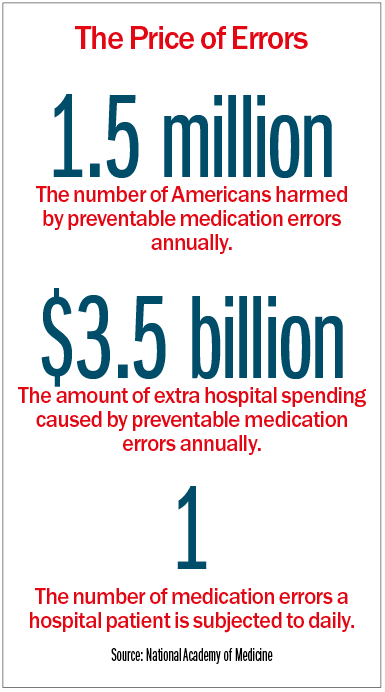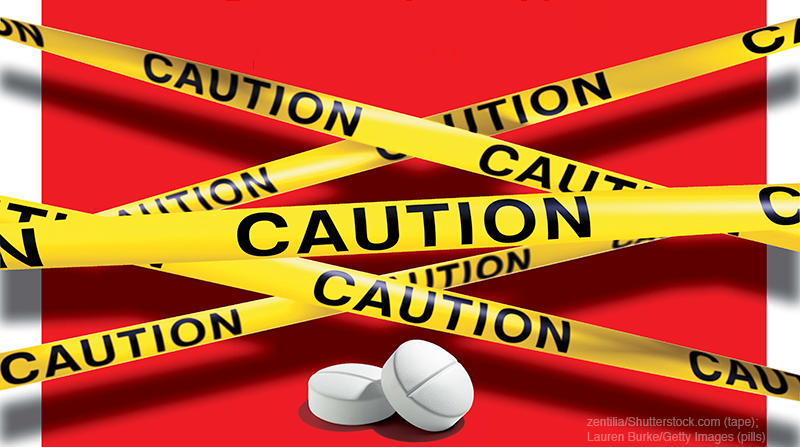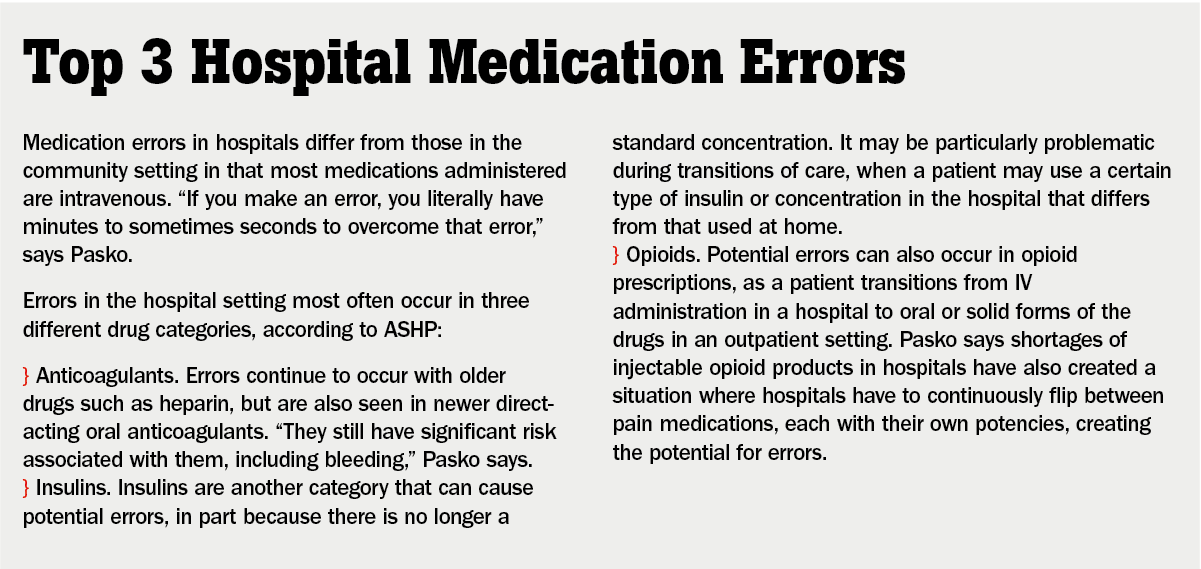How to Prevent the Top 4 Medication Errors
Drug errors generally fall into one of four categories-here's how the experts say those errors can be eliminated.
Click to expand


When a 71-year-old woman left the hospital after being treated for uncontrolled hypertension and acute kidney injury, her medication list included prescriptions for amlodipine (Norvasc), metoprolol, and doxazosin.
Over the next few months, the woman’s health continued to decline and she experienced fatigue, personality changes, and a “stoic” facial expression. She returned to the hospital several times and underwent an angioplasty after complaining of chest pain.
On her third trip to the emergency room, she was described as having a shuffling gait and bradykinesia. Her creatinine levels were elevated, but medical professionals could not determine the cause of her symptoms until a medication reconciliation revealed she’d been mistakenly given the antipsychotic Navane rather than Norvasc at her outpatient pharmacy three months earlier.
Related article: Top 5 Tips for Preventing Medication Errors
It was a mistake that caused significant negative health effects and was chronicled in a 2016 Journal of Community Hospital Internal Medicine Perspectives article.
Experts say this isn’t an isolated incident.
Medical errors of all kinds, including medication errors, are now the third highest cause of death in the United States and may be responsible for 10% of all deaths in the country, according to a 2016 study by Johns Hopkins Medicine. According to the National Academy of Medicine, preventable medication errors harm 1.5 million Americans annually and cost hospitals an additional $3.5 billion each year.
“I think the problem is becoming worse because this is a complex medical system that we have,” says Deborah A. Pasko, PharmD, MHA, senior director of medication safety and quality for ASHP.
Strategies to prevent medication errors in recent years include a move to electronic prescribing and adding barcodes to drug products. But experts say these efforts have not eliminated the need for vigilance among pharmacists, technicians, and other healthcare professionals in the community and hospital setting. Here’s more on the actions pharmacists need to take to avoid some of the most common medication errors.
Processing Errors
In busy community pharmacy settings, the most common errors are related to processing more than one prescription in a confined space, Drug Topics Editorial Advisor Michael R. Cohen, RPh, MS, FASHP, president of the Institute for Safe Medication Practices (ISMP), says. ISMP is devoted to improving medication safety and runs a voluntary practitioner medication-error reporting program.
“They put one patient’s prescription in another patient’s prescription, and then once it’s in the bag, they often will seal the bag,” Cohen says. The patient is sent home with the wrong medication and may not realize it. “It’s a very common thing when people come home with someone else’s bag due to this type of mix-up,” he says. “Usually it’s because [pharmacists] are working quickly.”
Cohen says the error can be avoided by leaving the prescription out of a bag until the patient arrives to pick up the medication.
The Medicine Shoppe in Two Rivers, WI, goes one step further. It performs a “show and tell” on every prescription. Drug Topics Editorial Advisor Marvin Moore, PharmD, owner of the pharmacy, says during patient counseling sessions they actually open up the bottle, pour some of the pills out onto the counter, and show them to the patient. This not only ensures the patient has the right prescription before they leave the pharmacy, but also opens up a dialogue between the patient and pharmacist.
“There are opportunities to catch things where the patient will say, ‘Oh, that was supposed to be changed,’ or, ‘I am supposed to take two a day now instead of one?’” Moore says.
If a potential error is noted, pharmacists contact the prescribing physician to verify any prescription orders.
Dosage Errors
Electronic prescriptions were introduced to reduce medication errors and have been said to increase adherence to first fill medications since their introduction.
In recent years, electronic prescribing systems have been embraced by most prescribers in the United States. According to a 2017 report from SureScripts, 77% of all prescriptions in 2017 were delivered electronically.
Related article: Why Drug Labels Are Set Up for Failure
But while experts say it’s been a move in the right direction, electronic prescribing hasn’t eliminated medication errors. Electronic systems just pose different types of error-related problems, says Carter High, PharmD, director of legislative affairs for Best Value Pharmacies in Texas. “The downside is they are only as good as the people who put in the information on the other side.”
Click to expand

Cohen says common errors include selecting the wrong item from the computer screen.
Moore says electronic prescribing can also introduce confusing or conflicting instructions in the patient directions, or Sig (signetur/label). “We also get a lot of prescriptions where they will pick a drug and a strength, and then in the Sig they’ll have a different strength,” he says.
Related article: What Bartenders and Pharmacists Have in Common
For instance, a prescription may be written for 20 mg of prednisone, but then the instructions will say to take 5 mg daily. Moore says the error may occur because prescribers don’t know how to correct certain defaults in the system, or they accidentally select the wrong strength from a dropdown list.
To avoid this type of error, Moore’s staff looks back at previous prescription data for a patient and follows up if there are any dose changes or other significant alterations to a prescription.
“We make a lot of calls during the day to prescribers’ offices to clarify,” he says. “Basically any time we see a change, if there’s not a note that says dose decrease or dose increase, then we call to verify, because you just don’t know. We’d rather be on the safe side and pester the nurse a little bit versus hand out the wrong strength.”
Best Value Pharmacies has implemented a six-point check that requires technicians and pharmacists to verify the patient’s name, drug name, strength, directions, quantity, and doctor for each prescription they fill to reduce errors. Walgreens has also instituted a multistep prescription filling process with numerous safety checks built in to reduce human error, says Tasha Polster, RPh, vice president of Pharmacy Quality, Compliance, and Patient Safety. “We continually evaluate ways to enhance our operations, technology, and training to help improve healthcare delivery and promote a culture of continuous quality improvement.”
Care Transition Errors
Another common time for medication errors is during transitions of care when patients move to different types of settings, such as the hospital to home, or from a rehabilitation facility to a long-term care center.
“The more steps we build in and the more transitions of care we have, unfortunately, it brings to light broken systems and where things could happen,” Pasko says.
This can be particularly problematic for insulin prescriptions, as there is no longer a standard concentration in insulin products. Many hospitals may only carry certain types of insulin on their formularies or may use a different concentration than the patient uses as an outpatient. This can create potentially dangerous situations.
Pasko says pharmacists should always be involved in transitions of care if possible. If a patient is being seen in an outpatient setting, Pasko, who used to work in a pediatric intensive care unit, says pharmacists need be proactive and ask patients questions such as whether any of their medications seem different, whether they look the same, and what time of day they are taking medications.
“If a patient comes to me and says, ‘At home I was taking it and it was peach and round and now it is green and oblong,’ that would prompt me to just take a step back and verify that’s the right thing,” she says.
Given the increased chance of a medication error during a transition in care, Moore says his pharmacists typically do a medication reconciliation for anyone recently transitioning from one care setting to another.
Related article: How to Differentiate Between Look-Alike Sound-Alike Drugs
Alert Fatigue Errors
Alerts are designed to warn healthcare providers about potential allergies, adverse reactions, or other health concerns, but they also bombard busy healthcare providers with information that may not be clinically relevant.
The result is that these alerts can be overridden or ignored. According to one 2013 study published in PLOS One that examined providers habits for drug-drug interaction warnings, more than 30% of alert overrides were considered inappropriate and subsequently put patients at increased risk for adverse events.
“That is a very, very common problem where people just hit the return key when they see an alert up on the screen,” says Cohen, who is also cochair of an allergy alert subcommittee for the National Information Technology Collaborative.
Related article: Four ways Pharmacists Can Improve Patient Counseling Skills
He points to a recently reported case in which a woman’s health history included information that she was allergic to fluoroquinolones. Yet, when she developed a urinary tract infection, a resident in the emergency room placed a verbal order for Levaquin. The nurse processed the order, as well as the pharmacy, never noticing the system alert to the allergy. They were about to administer the drug, when the woman told them of her allergy and refused to take it.
Other Errors
Medication errors also occur when pharmacies or electronic prescribers confuse similar sounding drug names. Tall man lettering, or capitalizing unique portion of a name, was designed to reduce these types of errors, but Cohen believes it isn’t fully being utilized.
He says the FDA has required manufacturers to use tall man letter for 20 name pairs but says ISMP believes this list should be expanded. The strategy would be more effective if the differences in drug names were highlighted by more than just capital letters, he adds.
“What we need to do is enlarge the font, not just with capital letters, but twice the size,” he says. “We need to bold those letter characters, we need to italicize them, we need to put background on them so they shout out to you: This is different.”
Other errors occur when pharmacists try to work too quickly or select the wrong containers. For instance, a pharmacist loading three containers into an automated dispensing machine may scan the barcode on one of the containers three times rather than scanning each one separately.
An effective strategy to preventing these type of errors is improving communication within the pharmacy and with patients.
High, who also serves as the operating manager for Best Value Rhome Pharmacy in Texas, holds monthly meetings to discuss potential errors that he caught before they left the pharmacy, using the meeting as a chance for his staff to learn.
“The feedback has worked really well,” he says, adding that in the last nine months that he’s been holding the meetings, the number of potential errors has been reduced by 70%.
Related article: Top Ways Pharmacists’ Roles Are Changing
Cohen says pharmacists also need to make a more concerted effort to talk with patients when a prescription is filled, particularly for high-alert drugs such as anticoagulants or insulins.
Technology on the Horizon
Technology can also be a critical aspect of reducing medication errors that can occur throughout the medication use cycle, such as barcode scanning, integrated electronic health orders, and tools such as smart infusion pumps.
“We really see the organizations that are moving the needle are the ones that have truly integrated electronic systems, which many still do not,” Pasko says of hospital settings.
Mark Neuenschwander, president of The Neuenschwander Company, which promotes sound deployment of medication-use automation, says bedside barcoding in hospitals is now nearly universal. It’s effective and reduces errors, as long as it’s used correctly. “If somebody gives the medication and then scans later, that’s like not putting your seat belt on until you are on the highway,” he says.
Neuenschwander is also a proponent of technology used to prepare medications that have to be reconstituted or remixed at a hospital.
Related article: Your 10 Worst Pharmacy Mistakes
“Liquids are high risk. So, we can use the same technologies in the clean room as we use at the bedside,” he says. This includes an automated check list of the recipe, product verification tools that use barcoding, and volume verification that must meet all the requirements before a label and barcode can be made.
Only about 20% of hospitals currently use this type of technology, and may not use it for everything, but he hopes it will become more widespread, says Neuenschwander, a Drug Topics editorial advisor. “I am not going to rest until we have universal adoption of preparation technologies for compounding,” he says.
